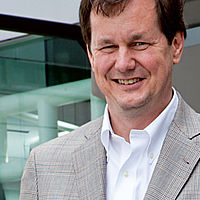In order for you to gain deeper insight into the everyday life of the automotive and rubber industry, which we are concerned with on a daily basis, Mixing Together has interviewed Mr Michael F. Ableson, member of the Executive Board of OPEL and vice-president engineering of GM Europe, about the future development of the automotive market as well as the far-reaching effects this future will have on us as manufacturer of machines.
Mixing Together: Mr Ableson, how do you see the automotive market developing in the next five years?
Michael F. Ableson: The registration of new vehicles in the European Union in 2012 is at the lowest level since 1994. Particularly affected are the Southern European markets. We do not see any indication of market improvement in 2013 and assume that the situation in the European market will tend to even worsen slightly, before recovering slowly in subsequent years.
Mixing Together: Which vehicles will develop stronger and which regions will be affected?
‘New drive technologies will catch up – also in regions whose automotive market is just developing.’
Michael F. Ableson: We see different parallel trends and no well-defined developments. On one hand, these are vehicles that comply with increasingly technological equipment and ever-increasing demands. At the same time, there will still be great demand for simpler equipped cars ranging in the lower price segment. New drive technologies will catch up – also in regions whose automotive market is just developing. If that is politically intended, this can happen very fast.
Mixing Together: How do you see the future development of the Chinese and Indian automotive markets?
Michael F. Ableson: The automotive industry of both nations has enormous potential. It will take some more time to tap the full potential. It is important to pay even more attention to the customers’ wishes: the manufacturers must tailor the products even stronger to these markets. The car buyers in these regions are demanding – they know very well what they want.
Mixing Together: Which general trends for cars do you see with regard to diversification and convenience, safety and energy efficiency?
Michael F. Ableson: Lightweight construction will be an integral part of the car concept. Part of the traffic safety is also the networked car with access to Internet and online navigation as well as the further development of telematics and driver assistance services. We continue to improve conventional engines where large potential still exists. Alternative fuels as well as the electrification of cars will still be the focus of attention.
Mixing Together: Which meaning will these trends bear for the rubber industry?
Michael F. Ableson: If electric mobility should prevail, tyre sizes will change, as well as the vehicles will have to be changed conceptually. The demands on the tyres will continue to rise, with rolling resistance coming to the fore. Currently driving dynamics and safety are the focus, but legislation (e. g. CO2 limits) could shift the focus.
Mixing Together: How do you see the development of e-mobility, in particular in terms of rubber products?
Michael F. Ableson: E-mobility stands and falls with battery technology. If this challenge is better controlled, there should be even more electric vehicles. But even for these cars, you will still need tyres, of course, with considerable change of requirements. The tyre will evolve to a bespoke product and only companies investing in development will be able to stay competitive.
Mixing Together: What will be the future requirements on CO2 emissions and what does this mean for rubber products such as tyres?
Michael F. Ableson: Tyre production – as well as other industries – will have to move away from the high-energy industry. Consumption of raw materials must be minimised. We can achieve this through the use of alternative materials, energy recovery and the reintroduction of recylced materials into finished products.
Mixing Together: In general, how will the demands on tyres change (rolling resistance, wear, traction and braking performance, use of renewable resources as a substitute, use of aromatic plasticisers)?
Michael F. Ableson: The rolling resistance will remain an important issue. But especially the overall energy balance will play a more important role. Since fewer and fewer people are able to realise the full potential of a vehicle and further speed limits are expected to rise, features important today such as handling, traction and braking performance will in future no longer be the only dominating factors. The braking distance, for example, could also be positively influenced through intelligent, predictive traffic systems. Renewable resources are already being tested and will be gradually introduced.
‘The tyre of the future will by trend be narrower and the tyre outside diameter will be rather larger.’
Mixing Together: What does this mean for the development of materials and for tyre constructions (wider and larger with respectively higher rubber consumption)?
Michael F. Ableson: The tyre of the future will by trend be narrower and the tyre outside diameter will be rather larger. Therefore, it is likely that rubber consumption will remain rather neutral. New materials are to be tested and used but however not within a short term and only if an improved spectrum of features for tyres would arise.
Mixing Together: Is it possible to replace the rubber in tyres?
Michael F. Ableson: Possible, yes, but that will certainly take a while. Currently, rubber is still the material with the best all-round properties. The share of synthetic rubber in tyres has risen to around 50 %, in so far the natural rubber has already been replaced to some extent.
Mixing Together: Will there be increased demand for thermoplastic elastomers, for example, sealing materials for doors and window panes?
Michael F. Ableson: We see a steady increase in the use of thermoplastic elastomers for the previously mentioned applications. Compared to previously used pure elastomers, thermoplastic elastomers have a clear economic advantage – not to forget the potential for recycling. The only disadvantage is the poor setting behaviour, which must be balanced through constructive solutions. The entire automotive industry is working on this intensively.
Mixing Together: How will materials based on renewable raw materials be used in future (NFP, WPC or similar)? What limits their use today?
Michael F. Ableson: Natural fibre-reinforced plastics, such as sisal, hemp and wood flour-reinforced plastics, have been used successfully in the automotive industry for many years. They are found in door panels, headliners, supporting plates and many other vehicle elements. It is important to pay attention to issues such as emissions. In this area, they play a much larger role than glass fibre-reinforced materials and inorganically filled materials. Since reducing total vehicle emissions is an endeavour pursued worldwide, new debates could arise. Compared to conventional materials, a recycling of natural fibre-reinforced materials cannot be realised that easily – especially in regards to fulfilling legal requirements.
Mixing Together: How do you see the development of biopolymers with regard to their possible application in cars?




